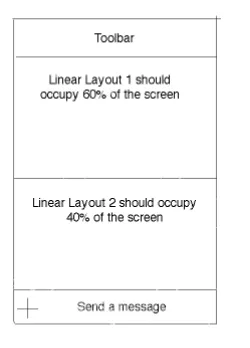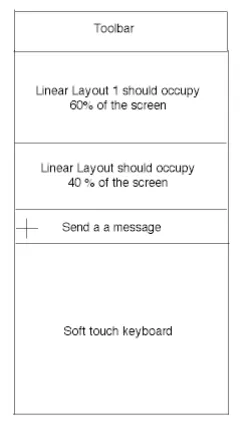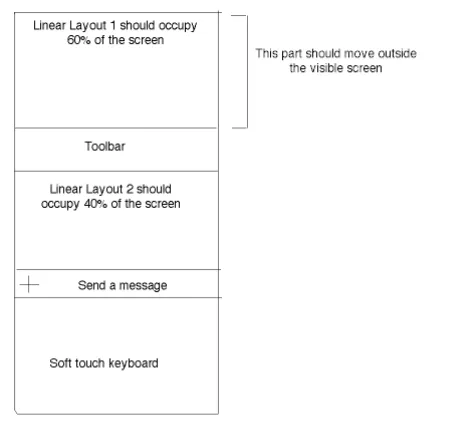我希望您能在聊天应用程序中拥有以下视图。基本上有两种状态,一种是显示软触摸键盘,一种是不显示。
因此,这是我的初始状态,没有显示键盘。
因此,这是我的初始状态,没有显示键盘。
键盘出现时会发生什么。
这就是我想要实现的。
注意 我目前正在使用"adjust-resize"作为windowSoftInputMode。我知道使用"adjust-pan"可以解决问题,但是使用"adjust-pan"会出现两个问题:
- 工具栏也会上移以腾出空间给edit-text和键盘。
- editText的一部分会被键盘遮挡。
需要布局专家的帮助! 提前感谢。
编辑:
这是我的XML代码:
<RelativeLayout
xmlns:android="http://schemas.android.com/apk/res/android"
xmlns:app="http://schemas.android.com/apk/res-auto"
xmlns:tools="http://schemas.android.com/tools"
android:layout_width="match_parent"
android:layout_height="match_parent">
<LinearLayout
android:id="@+id/view_group_toolbar"
android:layout_width="match_parent"
android:layout_height="wrap_content">
<android.support.v7.widget.Toolbar
android:id="@+id/toolbar"
android:layout_width="match_parent"
android:layout_height="?attr/actionBarSize"
android:background="@color/colorPrimaryDark"
android:elevation="4dip" >
<!-- Toolbar stuff -->
</android.support.v7.widget.Toolbar>
</LinearLayout>
<LinearLayout
xmlns:android="http://schemas.android.com/apk/res/android"
android:layout_width="match_parent"
android:layout_height="match_parent"
android:layout_above="@+id/bottom_bar"
android:layout_below="@+id/view_group_toolbar"
android:orientation="vertical">
<LinearLayout
android:layout_width="match_parent"
android:layout_height="0dp"
android:layout_weight="0.6">
<include
layout="@layout/layout_that_covers_60%_of_the_screen (This is not my actual layout name :/ using it for understandability)"
android:layout_width="match_parent"
android:layout_height="match_parent" />
</LinearLayout>
<LinearLayout
android:id="@+id/view_group_recycler_view"
android:layout_width="match_parent"
android:layout_height="0dp"
android:layout_weight="0.4"
android:gravity="center_vertical">
<include
layout="@layout/layout_that_covers_40%_of_the_screen"
android:layout_width="match_parent"
android:layout_height="match_parent" />
</LinearLayout>
</LinearLayout>
<RelativeLayout
android:id="@+id/bottom_bar"
android:layout_width="match_parent"
android:layout_height="60dip"
android:layout_alignParentBottom="true"
android:gravity="bottom"
android:padding="8dip" >
<!-- This is where my edit text resides -->
</RelativeLayout>
</RelativeLayout>


